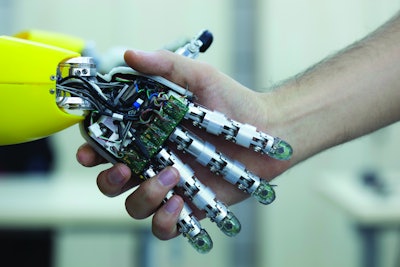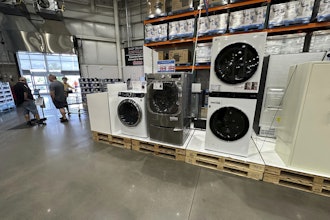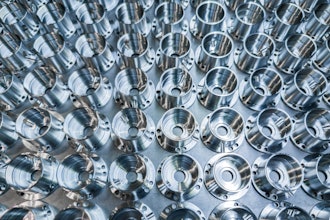
If you were to ask someone to describe their perception of a robot, they might think of Robbie the Robot, the fictional figure that appeared in the 1956 B-movie, The Forbidden Planet. Robbie was a fictional 7-foot tall robot that walked on mechanical legs. No wisecracks about my age here.
For many years people saw robots that way, but now that vision has changed remarkably. The number of industrial robots on the factory floor has soared as employers use them to perform a variety of tasks. In fact, the number one market for industrial robots is the health care sector, followed closely by manufacturing. Robotics engineers are eagerly sought by top manufacturing and software companies.
The International Federation of Robotics estimates that in 2013, about 168,000 industrial robots were sold — about five percent more than in 2012. Robot sales to the Americas continued to increase due to automation processes in North American industry. Additionally, robot sales to Asia rose considerably due to strong demand from China, South Korea, and other growing Asian markets.
Robots, proponents say, are making companies more competitive through automation and the ability to replace many jobs previously held by humans. But others claim that although lower skilled jobs are being phased out by automation, industrial robots will lead to more innovation and eventually higher paying jobs in the manufacturing sector.
There are a number of projects underway to bring even more robotics to the workplace. For example, Dimitry Berenson of the Worcester Polytechnic Institute (WPI) is collaborating with Julie Shah, Assistant Professor of Aeronautics and Astronautics at MIT, and Director of the Interactive Robotics Group in MIT’s Computer Science and Artificial Intelligence Laboratory, to begin laying the groundwork for robots that can safely and productively cooperate with people to build products in small-scale manufacturing operations. You can get more information on the project at this link: http://phys.org/news/2014-02-tackling-robots-floor-homes-video.html
By helping to make smaller manufacturers more competitive, the researchers hope to play a role in revitalizing American manufacturing, Berenson said.
“Right now, if you have a product and you would like to manufacture it competitively, you may have to send that work to factories overseas, which can be a daunting challenge. Robots allow small manufacturers to enjoy the same cost benefits that large companies have already realized. In fact, by putting robots on the manufacturing floor, it may be possible to bring many small-scale manufacturing jobs back home,” he said.
Researchers in the pioneering Robotics Engineering Program at WPI received the awards through the National Science Foundation’s (NSF) National Robotics Initiative to investigate and overcome fundamental challenges involved with robots working alongside people in settings such as manufacturing plants and the homes of the elderly.
Google is one company that has recognized the importance of robotic technology. During December, Google bought six robotic companies in a six-day period. Of their recent 12 acquisitions, at least eight of them are associated with robotics. They have remained quiet about their plans – which is not unheard of for Google – but clearly robotic technology and machine vision are seen as key components for the company.
One of those acquisitions, Industrial Perceptions, Inc. (IPI), is an imaging company that spun off of the Menlo Park robotics company Willow Garage. Before being acquired by Google in December, IPI was reportedly focusing on building advanced technology for manufacturing and logistics. This includes the ability to see and sort different objects, say, in a factory, according to the website www.gizmododo.com.
The acquisitions have led to speculation by a number of website blogs and articles in the New York Times. After Google purchased Boston Dynamics, another robotic firm, the Times wrote this: “The deal is also the clearest indication yet that Google is intent on building a new class of autonomous systems that might do anything from warehouse work to package delivery and even elder care.”
Noting the diverse use of industrial robots, the Times mentioned the SentrySafe factory in Rochester, NY, where a welder does not wear heat-resistant gloves and a face shield. Instead, a one-ton robot that towers eight feet above the production line spot-welds the tops and bottoms of safes before they continue down the assembly line, where a (human) colleague works some 20 feet away.
Of course Google isn’t the only technology company that has made a major investment in robotics. Just a few years ago, Amazon paid $775 million for Kiva Systems, a robotics company. Amazon reportedly will install up to 18,000 of these robots in their fulfillment centers to increase order efficiency. These short, orange-colored robots can carry and move entire shelf units of products to a central shipping point.
The question as to what all this means for jobs in the future is a hotly debated subject. Robotics will clearly see growth in the software and engineering areas.
But one thing is for sure: The days of the 1950s where one in four people were involved in some type of manufacturing is no longer here. Robotics, industrial automation, machine vision, and the like will make us more competitive in the world marketplace but it will also mean a severe change in the skills needed by manufacturers and distributors in the future.
It could also prove to be more costly for some manufacturers to redesign their factory floors because of the excess height and weight of some of these larger robots. Of course, nothing compared to the size of good old Robbie the Robot.
Jack Keough is contributing editor of Industrial Distribution. He can be reached at [email protected].






















